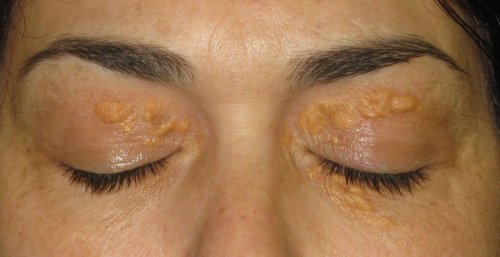Xanthelasma: Those White Spots Around the Eyes


Written and verified by psychologist Valeria Sabater
It’s possible that you’ve never even heard of xanthelasmas. They’re small white spots around the eyes that, if left untreated, become very unsightly benign tumors.
These small accumulations of fat appear around the eyelids, tear ducts, or around the eye sockets. When patients discover these white spots, they’re usually very surprised.
Many people attribute them to aging, the damaging effects of the sun, or in the case of women, just little blemishes that can be covered up with makeup.
But those little white spots around the eyes will eventually grow into bumps. In some cases, they become very large and patients have to resort to surgery.
Today, we’ll explain what causes them and what you should do if you notice some of these white spots around the eyes.
Xanthelasmas and cholesterol
We’ve already given you the first clue: cholesterol. These small benign tumors serve as organic depositories for cholesterol esters. This is a direct and striking response that tells you something is wrong with your body.
These white spots can also appear in other areas. Many people notice them on their knees, hands, or feet. In those cases, they are known as xanthomas.
We’ll provide more information below.
Are those white spots around the eyes dangerous?
Xanthelasmas are benign lesions that are almost always caused by high cholesterol levels in the bloodstream.
- A xanthelasma on its own isn’t severe or even related to a certain type of skin tumor.
- But if it’s the direct symptom of high cholesterol, then yes – it becomes a serious condition.
- That’s why you must go see your doctor for a checkup and treatment and follow a diet that will lower your cholesterol.
- Therefore, while xanthelasmas aren’t “fatal”, the cause for their appearance is actually quite dangerous.
- If a xanthelasma has already formed, it means that your risk of heart disease has increased significantly.
Xanthelasmas can appear on one eye or both. These yellowish or white spots are found in the upper layers of the skin and don’t affect the movement or vision of the eye itself.
They can also be caused by other skin diseases
Dermatologists tell us that these spots or bumps around the eyes aren’t always 100% linked to high cholesterol. There’s a small probability that you’re suffering from what is known as xanthogranulomatosis.
- This is a disease in which the dermis layer accumulates fat. It’s common for patients to present several firm and fatty nodules just under the skin, both around the eyes and on the legs.
- Xanthogranulomatosis is a fairly rare disease.
You might also be interested in: Broken Heart Syndrome, 3 Things to Consider
How are xanthelasmas treated?
First of all, as we noted above, you need to go to the doctor and identify what’s causing the xanthelasmas.
Due to the fact that cholesterol is typically behind this skin abnormality, the most important thing is to follow the proper treatment.
Then, you can try to solve their appearance. Don’t forget that xanthelasmas alter the way your face looks and are very unattractive.

There are many forms of treatment and your dermatologist will be able to tell you what your best option may be.
Surgery
This is the most common treatment, considering the striking size some of these fatty deposits can reach. But don’t forget that surgery too may leave its mark. The skin of your eyelids or under the eyes is very delicate and surgery can sometimes leave scars.
Trichloroacetic acid peels and CO2 laser
These techniques reduce the probability of scarring. The only thing they’ll leave is lighter-colored skin due to the small burns it causes.
Nd:YAG laser
This is another alternative to surgery that uses a laser to minimize or eliminate the lesions.
In the most serious cases, however, small skin grafts are often needed to repair the area around the eyes.

Surgery or laser treatment isn’t the solution to the problem: You need to be more aware
To conclude, we’ll once again repeat that xanthelasmas are benign tumors that disappear with appropriate intervention. However, you need to tend to your health and blood cholesterol levels.
According to various studies, when a person begins to see xanthelasmas, they can also begin to suffer from heart problems in the short or medium term. This is important to remember!
All cited sources were thoroughly reviewed by our team to ensure their quality, reliability, currency, and validity. The bibliography of this article was considered reliable and of academic or scientific accuracy.
- Blanco Mateos, G. (2005). Xantogranulomatosis orbitaria . Archivos de La Sociedad Española de Oftalmología . scieloes .
- Gervilla Caño, J., & Soler González, J. (2008). Xantelasmas. FMC Formacion Medica Continuada En Atencion Primaria. https://doi.org/10.1016/S1134-2072(08)70802-8
- Christoffersen, M., Frikke-Schmidt, R., Schnohr, P., Jensen, G. B., Nordestgaard, B. G., & Tybjærg-Hansen, A. (2011). Xanthelasmata, arcus corneae, and ischaemic vascular disease and death in general population: Prospective cohort study. BMJ (Online). https://doi.org/10.1136/bmj.d5497
This text is provided for informational purposes only and does not replace consultation with a professional. If in doubt, consult your specialist.








